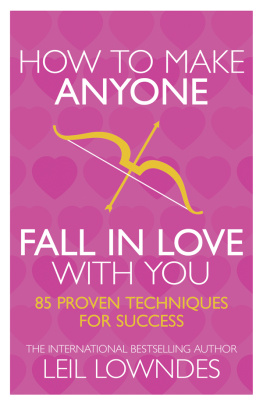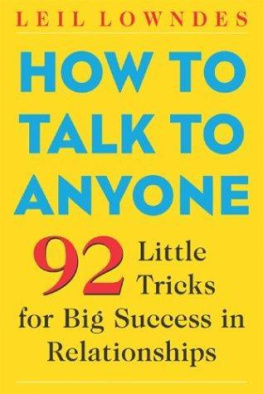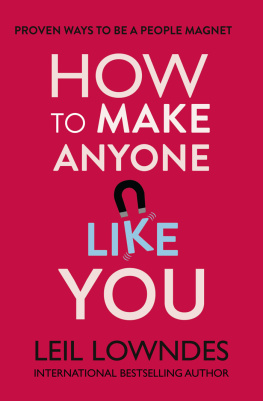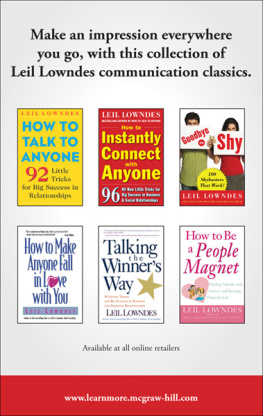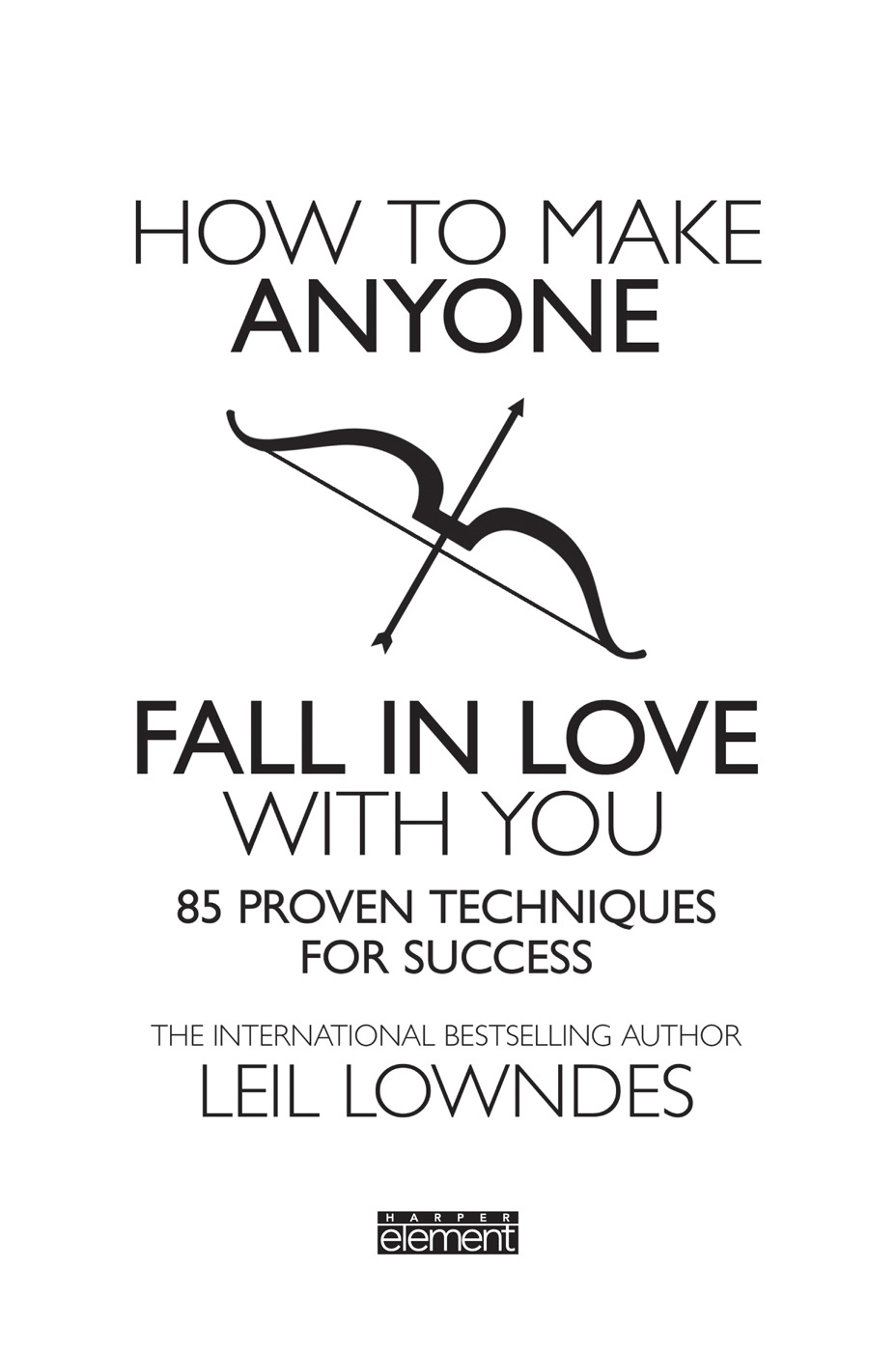To fulfil the promise of the title,
How to Make Anyone Fall in Love with You
offers 85 techniques based on scientific
studies into the nature of romantic love.
Contents
Anyone? Yes,
Practically Anyone
I dont understand. Im attractive, intelligent, sensitive, accomplished. Why doesnt he or she fall for me? Why cant I find love? How many times have you beaten your fists on the pillow asking yourself this question?
You open this book sceptically, yet harbouring hope, for the solution. You read the title: How to Make Anyone Fall in Love with You.
Thats a big promise, you say. Indeed, it is. But the promise of this book is yours if you are willing to follow a scientifically sound plan to capture the heart of a Potential Love Partner.
Why, when history is strewn with broken hearts, do we now claim the means to make someone fall in love with us? Because, after centuries of resistance, science is finally unravelling what romantic love actually is, what triggers it, what kills it, and what makes it last.
Just as ancient tribesmen saw an eclipse and thought it was black magic, we looked at love and thought it was enchantment. Sometimes, especially during those first blissful moments when we want to stop strangers on the street and cry out, Im in love! it may feel like enchantment, but, as we enter the 21st century, we are discovering that love is a definable and calculated blend of chemistry, biology and psychology. (And, well, maybe a little black magic thrown in.)
As science sets sail in previously unknown seas, we are at last beginning to understand the rudiments of that most insane, most delusive, and most transient of passions, as George Bernard Shaw described love. And what makes people want to stay in that excited, abnormal and exhausting condition continuously until death do them part? The question, and the quandary, of Precisely what is love? is not new. It is one that has been given serious consideration throughout the ages by cerebral heavyweights like Plato, Sigmund Freud and Charlie Brown.
In the darkened Broadway theatre in 1950, the audiences of South Pacific were in total harmony with Ezio Pinza when he pondered, Who can explain it? Who can tell you why? Fools give you reasons. Wise men never try. Well, recently, many wise men and women have tried, and succeeded. Dont blame Rodgers and Hammerstein. When they were composing romantic musicals, the scientific community was as perplexed about love as Nellie and Emile de Bacque singing their bewilderment about some enchanted evening.
Long before Sigmund Freud tackled the subject, analytical scientific minds agreed that love was basic to the human experience. But their rational brains also deemed that evaluating, classifying and defining romantic love was impossible and therefore a waste of time and money. Freud went to his deathbed declaring, We really know very little about love.
His dying words remained the scientific doctrine. At least until the early 1970s when a pioneer-spirited band of social psychologists took up the scientists constant cries of why? and how? They began asking themselves and everybody they could lure into their laboratories questions about romantic love.
Two women psychologists made a breakthrough by inadvertently focusing the attention of the modern press on the ancient question of What is love? Ellen Berscheid, PhD, with a colleague, Elaine Hatfield, managed to wangle an $84,000 federal grant to study romantic love. Berscheid convinced the National Science Foundation to open its coffers by declaring, We already understand the mating habits of the stickleback fish. It is time to turn to a new species.
Berscheids study, like others before, might have gone unnoticed and unpublished, except for a dozen or so pages in an obscure professional journal. Fortunately for love-seekers everywhere, one morning on Capitol Hill former United States Senator William Proxmire of Wisconsin was going through his papers. Buried deep in the pile was the NSFS frivolous grant to two women to study relationships.
Proxmire hit the dome! Eighty-four thousand dollars to study what? He dashed off an explosive press release announcement that romantic love was not a science and, furthermore, he roared, National Science Foundation, get out of the love racket. Leave that to Elizabeth Barrett Browning and Irving Berlin. Proxmire then added a personal note: Im also against it because I dont want the answer. He assumed everyone felt the same. How wrong he was!
Proxmires reaction set off an international firestorm that raged around Berscheid for the next two years. Extra! Extra! Read all about it. National Science Foundation Tackles Love! Newspapers had a field day. Cameras and microphones zeroed in on Berscheid with gusto. The quiet researchers office was swamped with mail.
Proxmires potshot at love had backfired. Instead of putting an end to the frivolous pursuit, his brouhaha generated tempestuous interest in the study of love. James Reston of the New York Times declared that if Berscheid et al could find the answer to our pattern of romantic love, marriage, disillusion, divorce and the children left behind it would be the best investment of federal money since Jefferson made the Louisiana Purchase.
It was as though Ellen Berscheid had pulled her finger out of the dyke. Ever since, there has been a torrent of studies scrutinizing every aspect of love. Respected social scientists with names like Foa, Murstein, Dion, Aron, Rubin and many others relatively unknown outside the scientific world have given us an as-yet-unopened gift a gift we will unwrap now: the results of their labours, their studies, teach us (although that was not their purpose) how to make somebody fall in love.
Granted, some of the studies do not guide us directly to that goal. To find the relevant studies, I had to comb through hundreds of scientific probings with cumbersome titles such as The Implications of Exchange Orientation on the Dyadic Functioning of Heterosexual Cohabitors. (What?) Some studies had mice listening to classical music, then jazz and blues, to see which made them hornier. which, I assumed, works only when a couples honeymoon cruise ship hits rocky seas.
My own first-hand research, although less daring, was no less vigorous. For more than ten years, before becoming a communications consultant and trainer, I was director of a research group I founded called The Project.
The Project was a New York City-based not-for-profit corporation established to explore sexuality and relationships. During my tenure with The Project, I interviewed and catalogued thousands of subjects on what they sought in a partner. I gathered information from the students at the dozens of universities where I was invited to speak on my research.
Like the work of researcher Ellen Berscheid, The Project experienced an unsought avalanche of attention which brought it to national attention. A Time magazine reporter covered one of our sessions and wrote a full-page article declaring Sex Fantasy Goes to Broadway, which, indeed, it did.
One arm of The Project had volunteers presenting psychodramatizations of their actual love fantasies on stage. Because there was no nudity and no explicit language, the squeaky-clean dramatizations were unique and caught the attention of the three major television networks, which presented excerpts of the vignettes on national programmes. This, in turn, spawned dozens of articles in respected mainstream publications in America and Europe.

